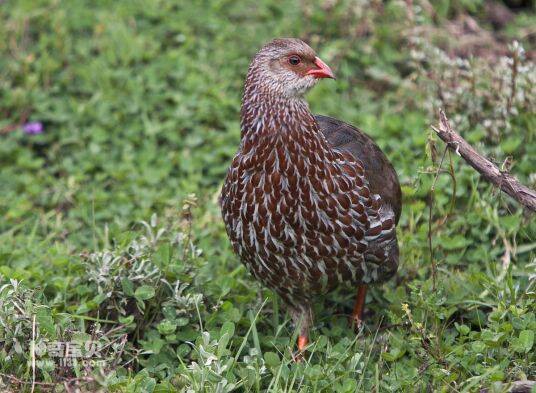Francolinus gularis
IUCN
LCBasic Information
Scientific classification
- name:Francolinus gularis
- Scientific Name:Francolinus gularis
- Outline:Landfowl
- Family:Chickeniformes Pheasants Partridges
Vital signs
- length:About 30 cm
- Weight:About 300g
- lifetime:No textual research information is available
Feature
It is easily distinguished from the ordinary partridge, the biggest difference is that it has relatively long legs
Distribution and Habitat
Distributed in the alluvial plains of the Ganges and Brahmaputra rivers, extending from Pilibhit to Assam, it even occasionally occurs in the Khasi Plateau, but it is not found in the Sundarbans.
Its habitat is different from other partridges, usually in tall grass and sugarcane fields near rivers and swamps, and it also forages into forage fields.
Appearance
The details are unknown.
Details
The swamp partridge, Francolinus gularis, is very territorial, and the males often fight for territory.

Swamp partridges like to travel alone or in pairs, and are good at forming flocks like other chickens. They fly very fast, often in a straight line. They are extremely vigilant and always hide in grass or bushes, making them extremely difficult to spot. When frightened, most of them fly to higher ground, which is different from other chickens. Sometimes three to five flock in search of food. When startled, they hide in the bushes very quickly and are hard to find. Strong claws, good at walking on the ground, although not often flying, but flying fast. It is omnivorous, mainly feeding on insects such as grasshoppers, locusts, crickets and ants, and also eating various herbs, buds, leaves, berries and seeds of shrubs, as well as grains, rice grains, peanuts, yellow millet and other grains scattered in farmland, sweet potato, pinellia, locust tree fruit, rape flowers and so on.
The breeding period of swamp partridge is from March to June, and mating begins in March to April. Calls are more frequent during courtship, often on rocks, tree stumps, shrubs, or tree branches, especially at dawn and dusk, when one bird calls first, followed by other males. Nest in grass or scrub on a hillside. The nest is simple and rough, mostly made of hay and branches, with a few feathers inside. Each litter lays 3-6 eggs, up to 8 eggs. The eggs are oval or pear-shaped and pale yellowish to yellowish brown in color. Incubation is carried out by the female bird, which is very fond of the nest, and the incubation period is 21 days. The young birds can follow the parent birds soon after the shell, such as natural enemies attack, immediately drill into the grass to hide, and the male birds are good at leading the enemy away.
IUCN Red List Protection Level: Vulnerable (VU).
Protect wild animals and eliminate wild meat.
Maintaining ecological balance is everyone's responsibility!








